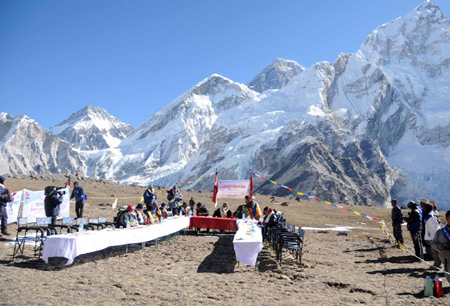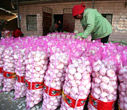Asia-Pacific
Nepal ministers talk green on snowy heights
(Agencies)
Updated: 2009-12-05 08:57
SYANGBOCHE, Nepal: Nepal's coalition government basked in the global limelight on Friday with Prime Minister Madhav Kumar Nepal leading a historic meeting of his cabinet in the shadow of Qomolangma, the highest peak in the world, to draw the attention of the rich nations to the perils of climate change.
|
 Nepalese Cabinet members attend a meeting at Kala Patthar in the shadow of Qomolangma on Friday. They held the meeting near the Qomolangma base camp to highlight the negative impact of global warming on the Himalayas. [Agencies] |
Top Nepalese politicians strapped on oxygen tanks and held the meeting amid frigid, thin air to highlight the danger global warming poses to glaciers, ahead of next week's UN climate change conference in Copenhagen.
The government billed the stunt as the world's highest cabinet meeting. The ministers posed for pictures, signed a commitment to tighten environmental regulations and expand Nepal's protected areas, and then quickly flew away.
"The declaration was a message to the world to minimize the negative impact of climate change on Mount Everest and other Himalayan mountains," the prime minister later said.
Scientists say the Himalayan glaciers are melting at an alarming rate, creating lakes with walls that could burst and flood villages below. Melting ice and snow also make the routes for mountaineers less stable and more difficult to follow.
Nepal's cash-strapped government spent only 1 Nepali rupee though the expedition cost more than Rs 6 million ($81,080). The entire expense was borne by the private sector related to tourism.
After criticizing the meeting as a gimmick, many grudgingly praised it because of the immense world interest it generated.
Getting the ministers to the mountain safely required extensive planning. Nepal, his two deputy prime ministers and the 20 cabinet ministers were examined by doctors before boarding helicopters to Kala Patthar, a flat area at an altitude of 5,545 m next to the Qomolangma base camp, the jumping point for climbers seeking to scale the peak.
The Himalayan Rescue Association's Bikram Neupane said the politicians - bundled in thick jackets, windproof gear and woolen hats - all had adequate oxygen levels in their blood and they were in no immediate danger.
The cabinet spent only 20 minutes next to the mountain on a clear, sunny day in an effort to prevent any of the ministers, unused to the heights of the Himalayas, from getting altitude sickness.
Several of the ministers were overweight, some in their 70s, and many came from the low-lying plains in the south. Four ministers declined to attend either because of health concerns or because they were traveling abroad. And though rescue helicopters were on standby, none of the officials fell ill.
The ministers spent Thursday night in the town of Lukla at an altitude of 2,800 m to acclimatize to the higher elevation. They then traveled to Syangboche (3,900 m), from where they took the helicopters to the world's highest mountain.
The event was intended "to get the world's attention on the impact global warming is having on underdeveloped countries like Nepal," Environment Minister Thakur Sharma said.
AP










